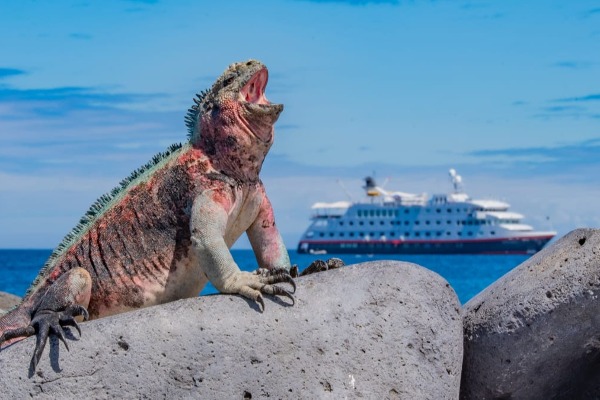IGTOA Calls For Limits On Galapagos Tourism Following UNESCO Report

Following the release of UNESCO’s 2023 State of Conservation Report raising concerns about unsustainable tourism growth in the Galapagos, the islands International Galapagos Tour Operators Association (IGTOA) is calling upon the government of Ecuador to limit land-based tourism growth in the Galapagos Islands and to better regulate this rapidly growing sector of the islands’ tourism industry.
In a letter to Mauricio Efraín Baus Palacios, Ecuador’s permanent UNESCO delegate, IGTOA asked the government of Ecuador to make good on its 2017 commitment to adopt a zero-growth Galapagos tourism strategy and to regulate land-based tourism as carefully as it has regulated ship-based tourism. Both Lazare Eloundou, Director of the UNESCO World Heritage Centre and Tim Badman, Head of the IUCN World Heritage Programme, received copies of the letter.
IGTOA, a 501c3 non-profit founded in 1997, and UNESCO have both been sounding the alarm over Galapagos tourism growth and its potentially disastrous consequences for more than two decades.
In 2007, UNESCO took the extraordinary step of adding the islands to its List of World Heritage in Danger, citing uncontrolled development of tourism as a factor in its decision. Although the islands were removed from the list in 2010, tourism growth has since continued unabated, the period of the pandemic notwithstanding.

Statistics published by Ecuador’s Ministry of Tourism show that tourist arrivals have increased steeply since then, from just over 170,000 in 2010 to more than 270,000 in 2019 (nearly a 60% increase). In April, a Ministry of Tourism press release celebrated the arrival of a record 32,509 visitors in March, a 24% increase over March 2019, and announced a new flight to the islands from the city of Manta, which will only fuel continued tourism growth. If the current growth rates continue unabated, the Galapagos will welcome one million annual visitors by 2041.
The UNESCO report notes that in 1998 Ecuador placed a firm cap on the total capacity of the Galapagos passenger fleet. This cap placed a de facto limit on the number of ship-based passengers that can visit the islands annually. 100% of the growth in tourist arrivals since then is the result of the ever-increasing popularity of land-based tourism in the islands, facilitated in part by a huge increase in the number of hotels and overnight rentals operating in the islands.
According to IGTOA board president Jim Lutz of Vaya Adventures, the issue isn’t that ship based tourism is necessarily better than land-based tourism.
Said Lutz: “Many of our members sell land-based tours. But it needs to be as well-regulated and well managed as the ship-based sector of the industry is. For many years, Ecuador’s management of ship-based tourism in the Galapagos has served as a model for the rest of the world for how tourism and nature can successfully coexist. We believe a similar approach needs to be adopted with respect to land based tourism. It is simply not sustainable to have never-ending tourism growth of any kind in a place like the Galapagos.”
IGTOA board member, Marcy Patry, of CNH Tours, observed that: “The Galapagos Islands are among the world’s most ecologically pristine and intact natural environments. They are home to many species found nowhere else on Earth and they are incredibly fragile. Well managed tourism can continue to play an important role in the ongoing protection of the islands. But it’s a double-edged sword. Uncontrolled growth and no plan to deal with it is a potential recipe for disaster.”

The uncontrolled growth of tourism, according to scientists, poses several serious threats to the Galapagos Islands. Chief among them is the potential for devastating new invasive species to arrive as cargo shipments and passenger plane arrivals increase. Highly invasive Wild Blackberry, for example, has led to the loss of 99% of endemic Scalesia forests on the two largest islands, Isabela and Santa Cruz. With any increase in land-based tourism comes more shipments of cargo, more infrastructure, more roads, and more pressure for continued growth, something that will only become harder to stop the longer it continues.
IGTOA has recommended a number of actions to limit the growth on land-based tourism, including increasing the visitor fees substantially — to bring them more in line with other international nature destinations such as the Serengeti — and putting a cap on the total number of hotels in the islands or on the total number of land-based visitors.
IGTOA points out that there is an absolute limit on the number of berths on vessels in the Galapagos, and it creates an absolute ceiling on the number of vessel-based visitors. A similar approach could be adopted for hotels and land-based tourism, and this would help protect the Galapagos from the immense pressure for continuous growth that has plagued so many other destinations worldwide.
Go to http://www.igtoa.org/ for more.


